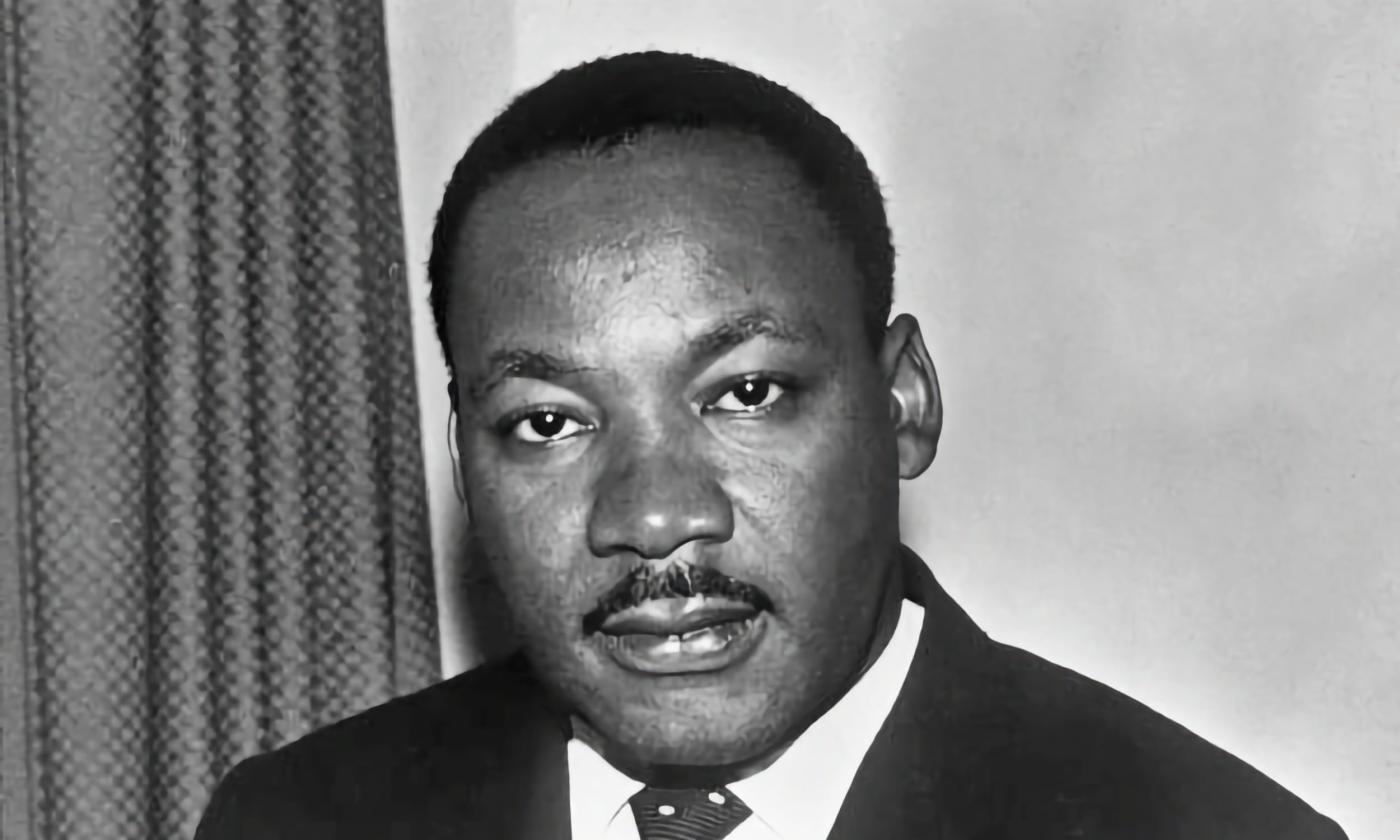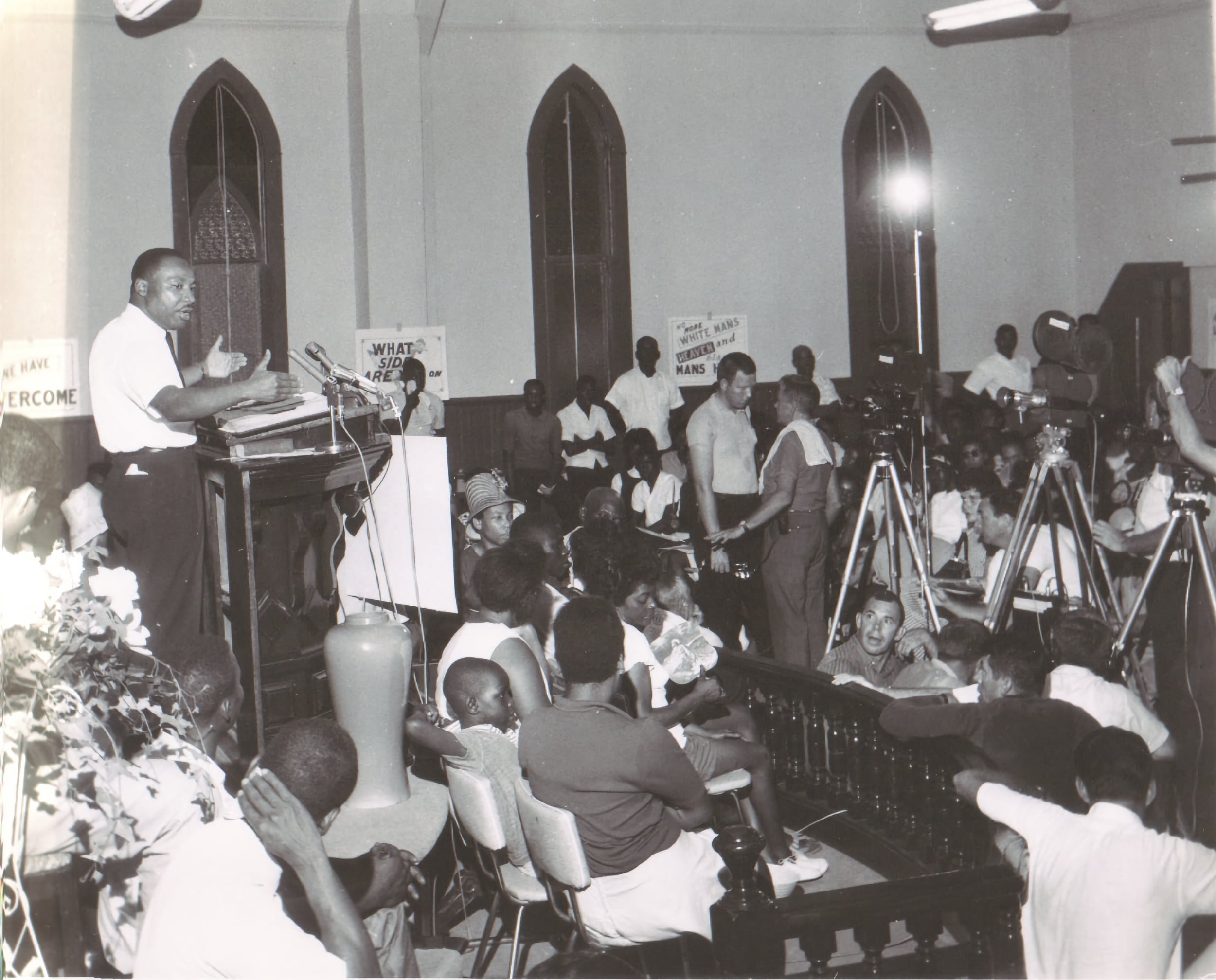
Dr. Martin Luther King Jr.
MLK was an orator, Reverend, and iconic Civil Rights activist.
Dr. Martin Luther King Jr.
Childhood in Atlanta
Reverend Dr. Martin Luther King Jr. was born on January 15, 1929, as Michael King Jr. His parents, Alberta Williams King and Rev. Martin Luther King Sr., were active in Atlanta’s Baptist community. There, they raised middle-child Martin alongside his older sister, Christine, and younger brother, Alfred. All three siblings grew up to become activists and educators.
During his childhood, young Martin witnessed his father rise through the ranks as a Baptist Pastor at Ebenezer Baptist Church in Atlanta, Georgia. He was also president of the local chapter of the National Association for the Advancement of Colored People (NAACP). Being a pastor's son, Martin's childhood was a structured one. Through church services and community events, he came to value the harmonious union of faithful people in his hometown.
However, growing up as a Black boy in Jim Crow Georgia meant experiencing daily racial discrimination. As Martin accompanied his parents on errands, he began to understand the harsh reality that his family faced because they were Black. As he started questioning his environment and the injustice he experienced, Alberta and Martin Sr. urged him to respond with love and compassion when faced with adversity.
Higher Education & Early Life
As a child, Martin attended several Black schools in Atlanta and demonstrated much academic prowess. Indeed, he even skipped 9th and 12th grade. At the age of 15, on September 20, 1944, he enrolled in Morehouse College in Atlanta, majoring in Sociology.
Apart from his academic pursuits, King worked as an assistant in his father's church and later became a minister at Ebenezer Church, where he was ordained on February 25, 1948. In that same year, he graduated from Morehouse with a bachelor's degree in sociology on June 8. He was only 19 at that time.
On September 14, 1948, Martin Luther King Jr. enrolled in Crozer Theological Seminary in Pennsylvania. He continued to study religious and political philosophy and began socializing as a young adult. He graduated on May 8, 1951 with a Bachelor's degree in Divinity.
Later that same year, King began a PhD program in Theology at Boston University. As he earned his final degree, King also met Coretta Scott, who would become his wife on June 18, 1953. Coretta was a brilliant young woman who was studying music at the nearby New England Conservatory of Music.
The couple was blessed with four children: Yolanda Denise King (born November 17, 1955), Martin Luther King The Third (born October 23, 1957), Dexter Scott King (born January 30, 1961), and Bernice Albertine King (born March 28, 1963).
Minister and Activist
It is undeniable that Rev. Dr. Martin Luther King Jr. was a prominent Civil Rights Activist whose activity within the movement was infamous. He was an active agent of the NAACP, and was elected the organization’s vice president on August 25, 1955. Alongside other NAACP agents, including Rosa Parks and Ralph Abernathy, the organization led infamous demonstrations such as the Montgomery Bus Boycott.
The city-wide protest in Montgomery, and the subsequent arrest of Mrs. Rosa Parks, spurred the young Dr. King into further action. In 1955, he became leader of the Montgomery Improvement Association (MIA).
The MIA evolved and grew, eventually becoming what is now known as the Southern Christian Leadership Conference (SCLC). Dr. King was appointed leader of the SCLC on February 14, 1957. The SCLC's objective was to proactively organize peaceful demonstrations in communities, with the aim of ending inequality, violence, and injustice against Black people.
It is important to remember that throughout their battle for African-American Civil Rights, Dr. King and his fellow activists were subject to beatings, imprisonment, police brutality, and even bombings. Despite this, he strongly believed in using nonviolent methods to accomplish the organization's goals.
The strange circumstances in the South and the pure power of King's presence and message earned the Civil Rights Movement national and international media attention. Dr. King also traveled the world in the late 1950s, visiting Nigeria, Italy, France, and the United Kingdom. His reflections on individual freedom during these trips inspired him to consider how he could utilize these experiences to tackle some of the societal issues that existed in America. Additionally, during his travels, he visited India and established a relationship with Prime Minister Nehru.
King's Campaign in St. Augustine
St. Augustine’s citizens were determined to achieve desegregation but faced obstacles in organizing effective demonstrations and gaining support due to disagreement over the approach. The Ku Klux Klan was a major force in the city, and their violence and intimidation tactics led to King labeling St. Augustine as"the most segregated city.".
Robert Bagner Hayling, the father of the Civil Rights Act of 1964 reached out to the SCLC, requesting assistance with the ongoing struggle for economic and political rights in St Augustine. C.T. Vivian suggested that the SCLC approve the request for assistance and activists of different ages and races helped Hayling with sit-ins and other demonstrations.
As many people from in and outside of the community participated in the protests, they were arrested and given unfair fines and bail fees, which were up to $1,000.00 per person.
Hayling, along with other community leaders, were determined to promote peaceful protests, increase job opportunities for African Americans, eliminate segregation, and establish a diverse committee to manage city decisions.
Martin Luther King, Jr., along with members of the SCLC, arrived on May 18, 1964, and stayed until July 1, 1964, with the aim of gaining national attention for their collaborative efforts and expediting the Civil Rights Act.

To boost morale, King delivered speeches in public spaces, including St. Paul's A.M. E. Church (85 Dr. Martin Luther King Jr. Ave.) and St. Mary's Missionary Baptist Church (69 Washington St.).
Martin Luther King Jr. stayed at 156 Martin Luther King Jr. Drive in St. Augustine with nurse Janie Price, whom he had met while attending Morehouse College.
Due to safety concerns, King left and stayed at 5480 Atlantic View on June 7, 1964, with Mr. and Mrs. Canright. Unfortunately, the house was shot at after information about King's stay was televised.
King then received support and shelter from several activists and supporters, including Cora Tyson, whose home is located at 81 Bridge St. Visitors to her home, including King, signed her family bible.
In an effort to continue SCLC’s work and to take a strong stance against racism, King and other activists marched at the Historic Public Market, formerly known as the Slave Market, located at St. George Street and Cathedral Place. They also protested at the Monson Motel situated at 32 Avenida Menendez. The motel was ultimately demolished in 2003 and replaced with the Hilton St. Augustine Historic Bayfront.
On June 11, 1964, King and members of the SCLC encountered segregation laws in full effect when they arrived at the Monson Motel. The manager, James Brock, refused to let them into the area. Despite the resistance, King and his group stood their ground and were subsequently arrested and taken to the St. Johns County Jail located at 3955 Lewis Speedway.
While in jail, King wrote a letter to Rabbi Israel Dresner, urging him to take action in support of the Civil Rights Movement. Dresner answered the call and left New Jersey to encourage other rabbis to join the cause. On June 18, 1964, Michael Robinson, Murray Saltzman, and other rabbis were arrested for demonstrating at the Monson Motel.
The demonstrations would continue to escalate with media outlets reporting on the incidents surrounding the motel. Protestors jumped in the pool and photographs were taken of Brock pouring acid in their direction.
Despite the hatred and violence, activists of different races and ages fought against the oppression and on June 30, 1964, Governor C. Farris Bryant created a biracial committee for the people of St. Augustine. On June 31, 1964 and on July 2, 1964, President Lyndon enacted the Civil Rights Act, which prevents racism and segregation and protects U.S. citizens no matter their race or religion.
It was a huge success for all citizens, the leaders who made sacrifices for the Civil Rights Movement, and humanity as a whole. However, the battle would still rage on throughout different cities. The Civil Rights Act was passed, but acceptance was still out of reach for segregationists and their supporters.
More Noble than a Peace Prize
Martin Luther King Jr.'s dedication to the betterment of African Americans and humanity as a whole was evident in his activism. From the streets of Birmingham to the presidential office, King's leadership inspired pastors, rabbis, congressmen, activists, and the citizens of the nation.
King was more noble than a peace prize but on December 10, 1964, he was awarded the Nobel Peace Prize based on being a central agent of change in the Civil Rights Movement. Some additional awards that he received for leadership and courage include the Spingarn Medal (1957, NAACP), Russwurm Award (1957, National Newspaper), Most Outstanding Personality of the Year (1957, 1963 Time Magazine), John Dewey Award (1964, United Federation of Teachers), The John F. Kennedy Award (1964, Catholic Interracial Council of Chicago), Marcus Garvey Prize for Human Rights (1968, Jamaica), The Rosa Parks Award (1968, SCLC), and others.
King's legacy is celebrated in many ways, including the more than 1,000 streets named after him throughout the United States and Europe. His work continues to inspire activists and leaders, as well as his children, who also serve the nation.
Resources
Online Resources
- Tap here to read the New York Times article "Dr. King Describes St. Augustine As Most Lawless City He's Seen; Reports Threats on His Life in Florida — Shots Are Fired Into a Negro's Automobile,” June 6, 1964.
- Tap here to explore the Seattle Times project “Martin Luther King Jr.: An Extraordinary Life.”
- Tap here to explore Stanford University’s Martin Luther King, Jr. Research and Education Institute.
- Tap here to read the Florida Times-Union article "Martin Luther King Jr.'s stop in St. Augustine hastened passage of Civil Rights Act 1964,” by Scott Butler.
Further Reading
- St. Augustine, Florida, 1963-1964: Mass Protest and Racial Violence, edited by David Garrow, 1989.
- The Autobiography of Dr. Martin Luther King, Jr., edited by Clayborne Carson, 1998.

